T.S.S.
Tuscania 1922-1939, “Nea Hellas”
1939-1955, “
Please Note: Firefox and some other Search Engines may not be suitable
Use Google Chrome for this Web Page to load perfectly!
Please Note: All ssMaritime and other related maritime
sites are 100% non-commercial and privately owned, thus ssmaritime is NOT
associated with any shipping company or any other organisation! Although the
author has worked and has been involved in the passenger shipping industry for
well over 60 years, but due to his old age and poor health, he was forced to
retire. Yet, he has completed well over 1,435 Classic Liners, Passenger-Cargo
Liners as well as humble converted C3 converted Migrant Liners, which has
transported countless of thousands of folk to the new world, as well on
vacations’. I trust the features online will continue to provide Classic
Liner and Ship enthusiasts both the information they are seeking, but more so
provide a great deal of pleasure and relive many happy memories!
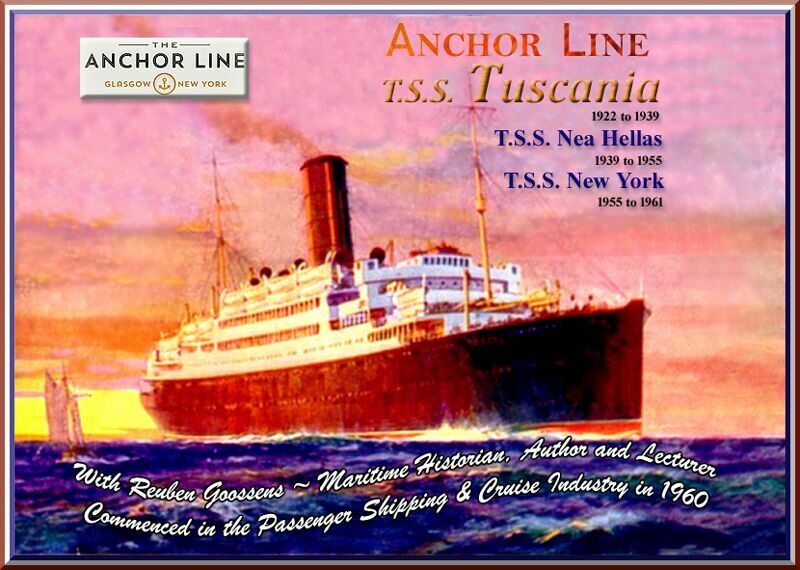
Postcards, photographs & other images are either from the author’s private collection or from my supporters.
Thus a very thank you to three very special ssmaritime supporters for sending me their wonderful
photographs & images for I could not have completed this feature to this point.
I am sorry but
some of the images shown may not be of the highest quality, but they are the
best that were available
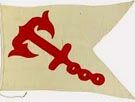
This is the “Anchor Line” House Flag
A Brief Introduction:
This delightful Scottish liner was built in 1922 as the T.S.S. Tuscania (2), for she was named after their earlier liner, then a troop ship the S.S. Tuscania of 1914, which was sadly lost during World War One, when in 1918 she was torpedoed and sunk by the German U-boat UB-77 while she was transporting American troops to Europe. There was a sad loss of 210 lives.
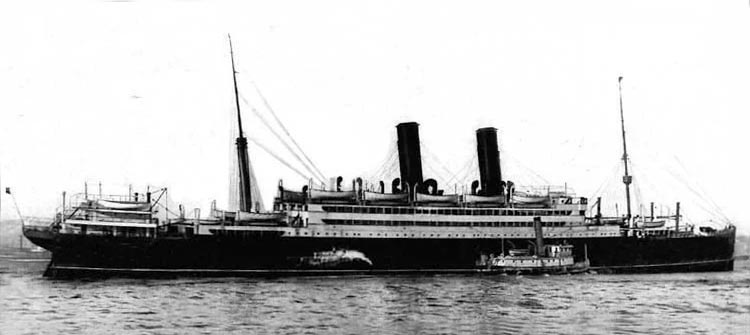
The 14,348 GRT luxury liner S.S. Tuscania (1)
The “Tuscania” (2) “operated
for 19 years, and then she changed hands and had two other names as she was
purchased by the “Greek Line” in 1939, and she became the
“Nea Hellas” and she famously carried allied troops across to ports
around the world as well as immigrants from the Old to the New World, and
countless tourists and operated many holiday cruises. Then in 1955 the company
changed her name to “
*********************
Construction to Delivery:
The T.S.S. Tuscania was built by Fairfield Co,
Ltd,
She was launched on October 4, 1921, and she was towed to the builder’s fit-out berth where she would be finished. She was completed early September 1922, and the “Tuscania” was a ship that had state of the art engineering for her day. She was a fine looking 552.3 ft - 168.3 m long liner with two tall masts, a single slender tall black funnel and she was powered by six steam turbines and with her twin screws she sailed at a respectable 16 knots service speed.
She undertook her Sea Trials on September 8,
1922, and achieved an excellent 17.5 knots maximum speed during her speed
trails. After a paint touch up, she was officially delivered to her owners at
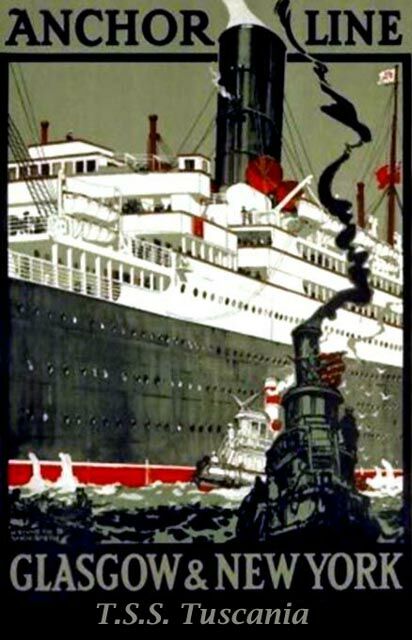
A Promotional poster of the T.S.S. Tuscania
Maiden Voyage and Voyages:
Once the “Tuscania” had arrived at
her home berth, she was made ready for her big day being the day of her maiden
voyage. Then on September 16, 1922, she was
filled with happy passengers all awaiting her departure for her maiden voyage
sailing via Moville (
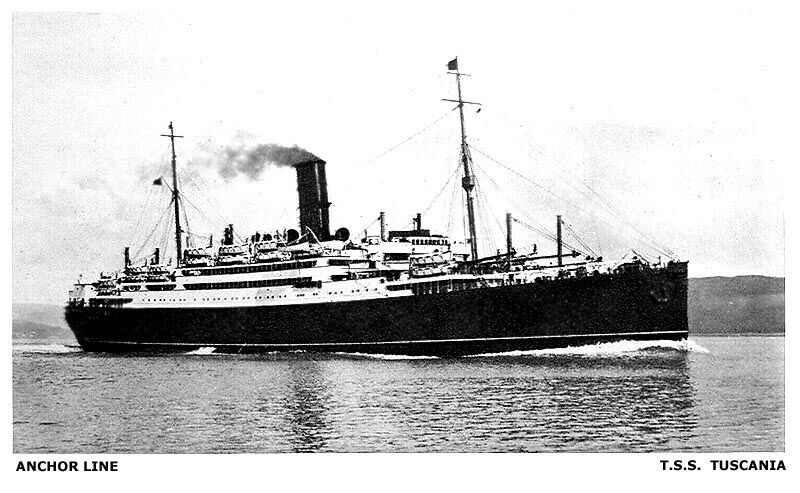
An early Anchor Line postcard of the “Tuscania”
For the next three years T.S.S. Tuscania continued on her regular new York services, but she also operated 5 Mediterranean voyages from New York, then in May 1926 made her last voyage from Glasgow to New York, Plymouth, Le Havre and concluding at London.
*********************
Interiors:
“Tuscania’s” interiors were rather beautiful, although like some ships, not so much over the top, but certainly quietly elegant and they were greatly appreciated by her passengers. Like on many liners of her day a variety of quality timbers were used throughout her venues, as was marble, and fireplaces were found in many venues, as we will see below.
Sadly I do not have many photographs
available, only those that were kindly provided to me by Donald Mackenzie of
First Class:
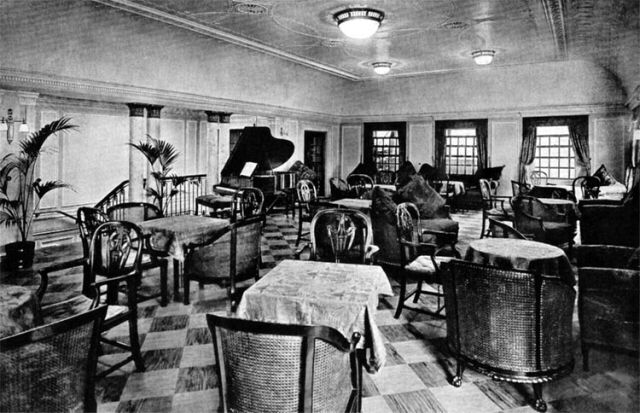
This is a view to the entrance of the lounge via the Grand Stairs
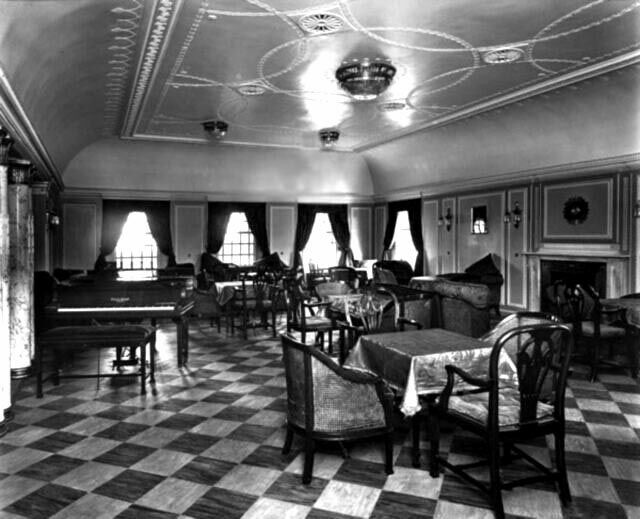
Above & below: Two views of the Main Lounge & below the Drawing Room
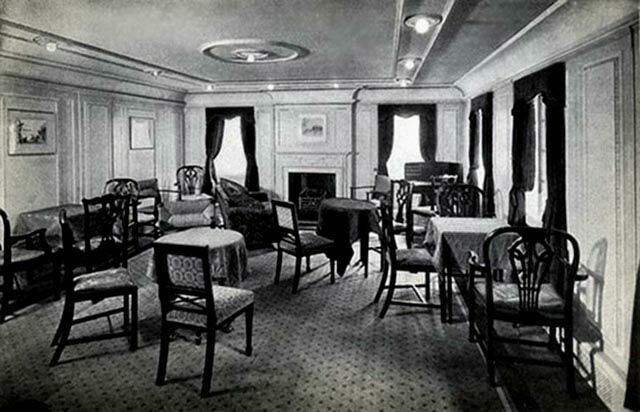
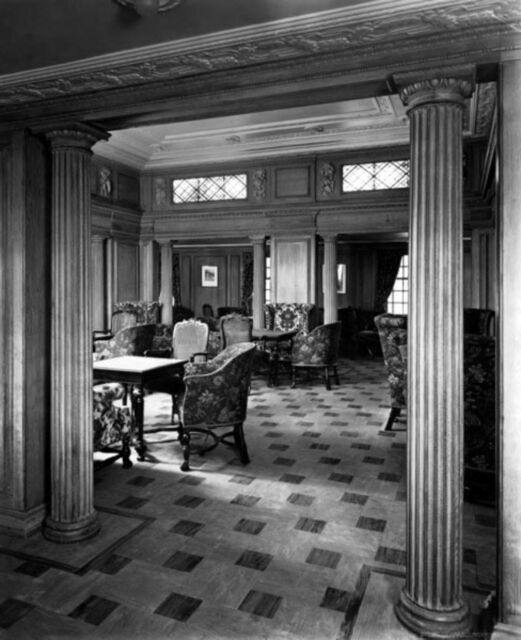
Above &
below: The stunning Smoking Room & below its
fire place
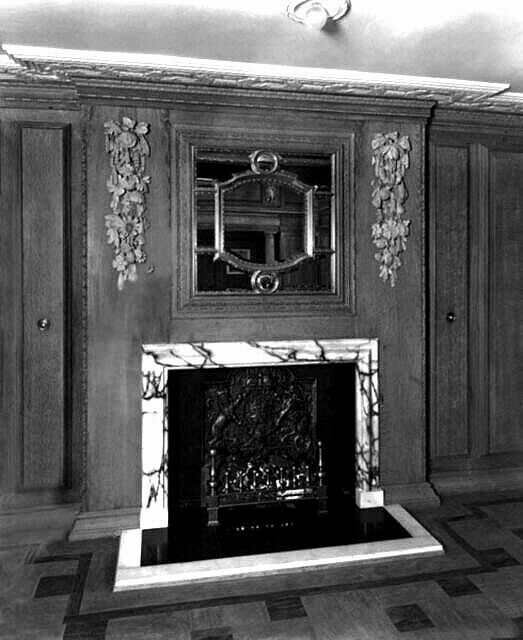

The Writing Room

Above & below: The Dining Room and a small colour version from a brochure
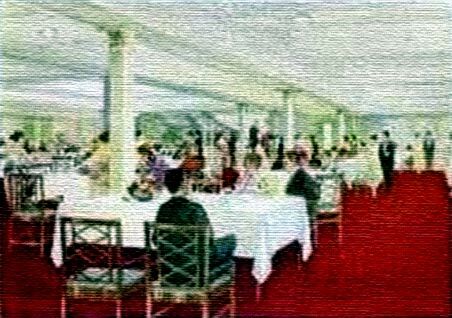
The Dining Room
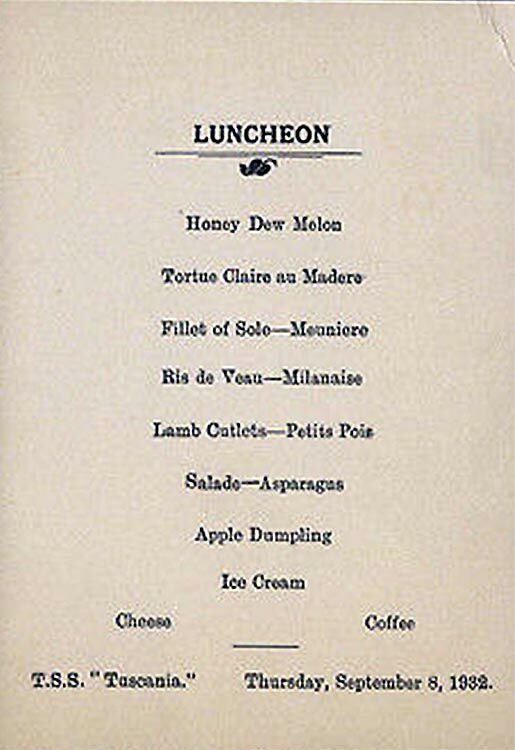
A Lunch Menu dated Thursday September 8, 1932

And this is a Diner Menu from Sunday June 23, 1935
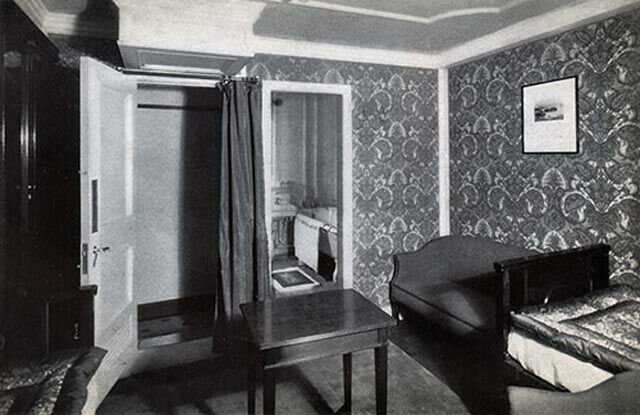
Here we see a twin bedded stateroom with a sofa and a private bathroom
*********************
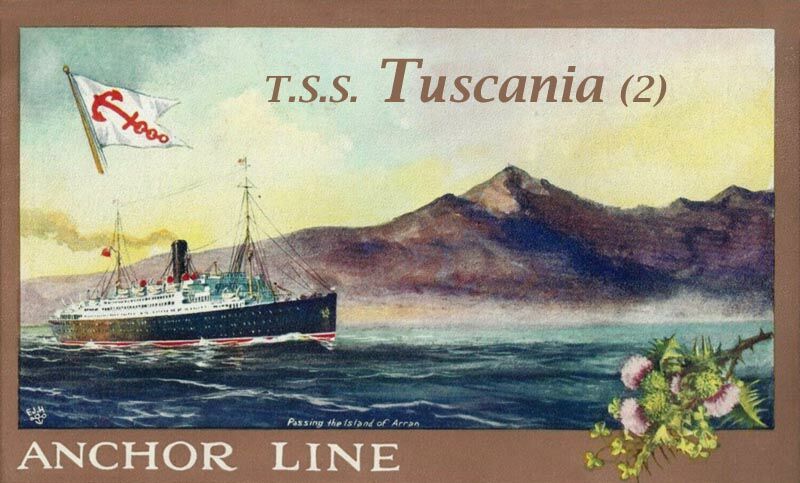
An ‘Anchor Line’ brochure cover
Second Class:
Her Second Class was also very well furnished as you will see from the two images below.
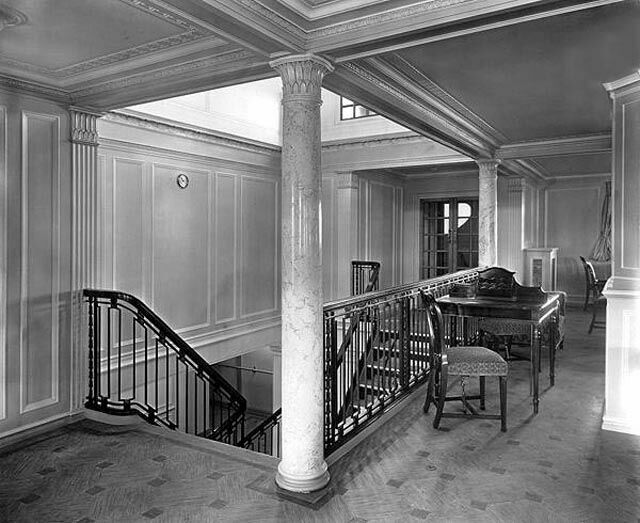
A secondary stairwell from their promenade deck
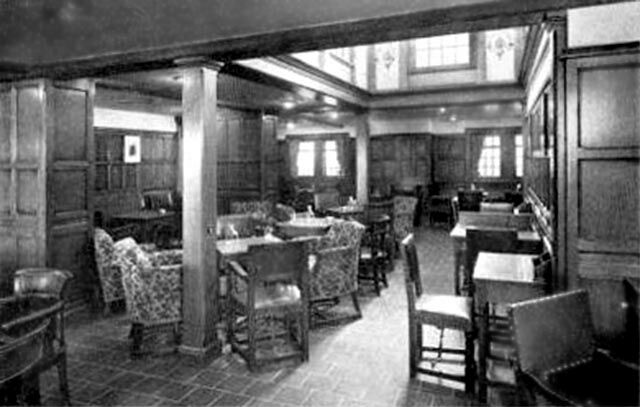
The Smoking Room had a fine dome above with windows allowing light during the day

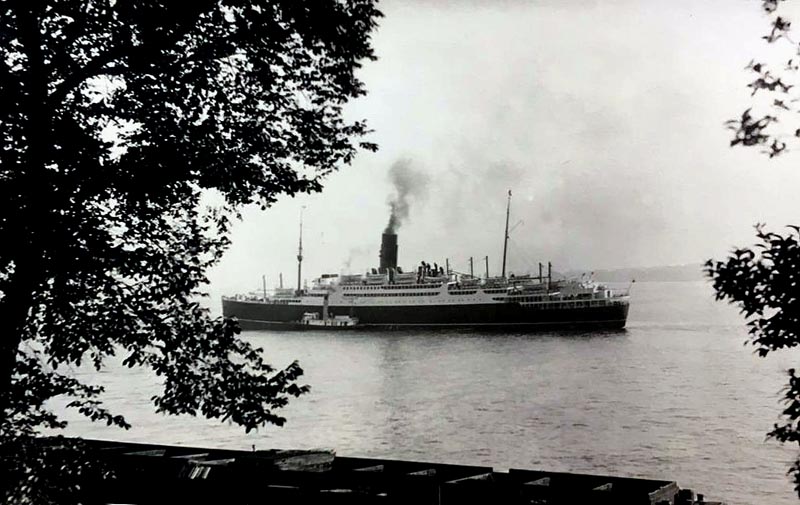
T.S.S. Tuscania is seen in the 1930’s
*********************
Souvenirs & Memorabilia:
Like most ships, the ships shop would have available certain items for passengers to purchase as a memory of their voyage, and below are just some, as well as three items from the dining room tables.
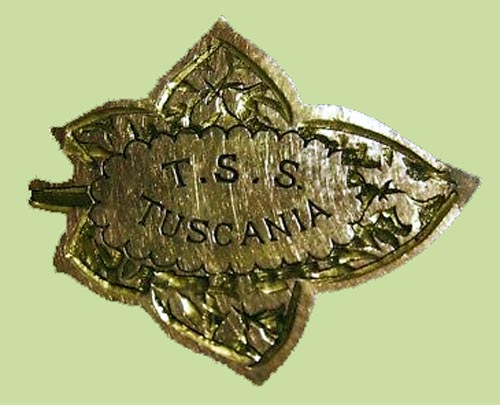
An unusual gold
brooch with T.S.S. TUSCANIA on it
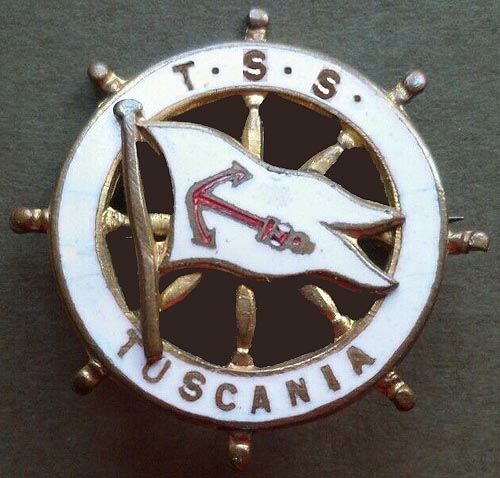
This pin or badge is far more traditional and typical of those obtained on board
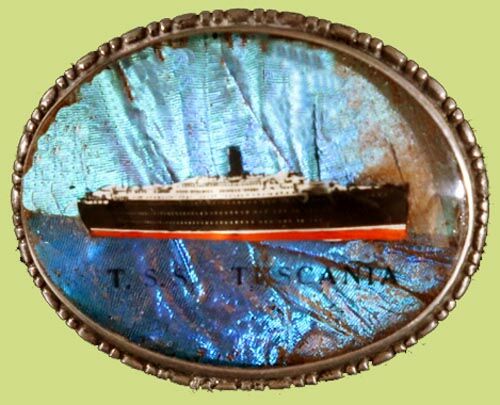
A Sterling Silver with a Vibrant Blue Hand painted T.S.S. Tuscania image Brooch
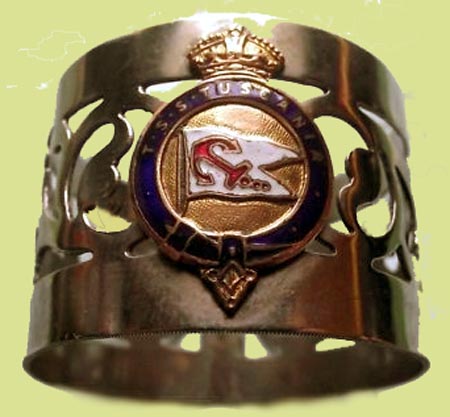
A highly polished Anchor Line T.S.S. Tuscania Napkin Ring obviously taken home from the ship

Above & below: A butter knife that also somehow ended up in someone’s suitcase
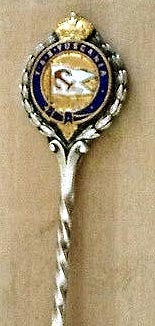
*********************
Her ‘Cunard’ Voyages:
The reason for that last “Anchor
Line” voyage was that she had been chartered by “Cunard Line”
for their
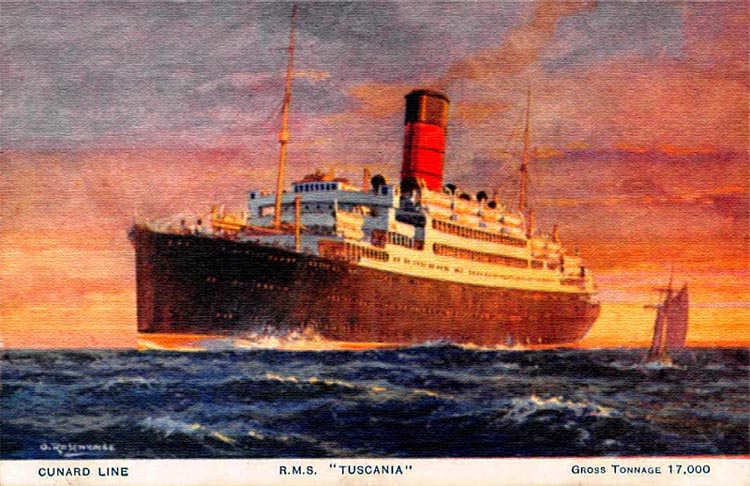
A postcard of the now prefixed R.M.S. Tuscania released by the ‘Cunard Line’ in 1921, in their livery
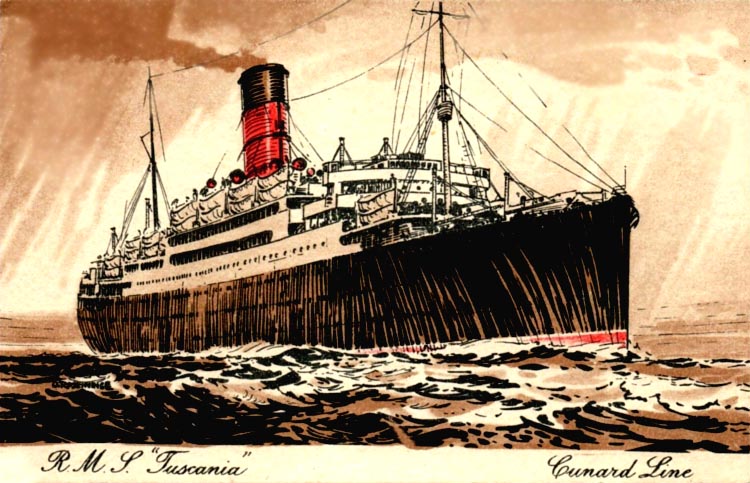
She departed from
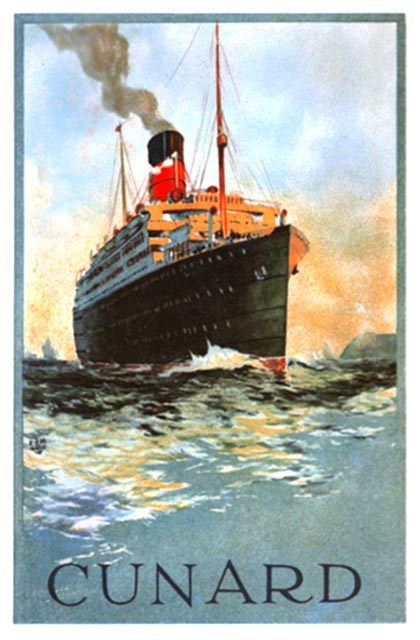
Here is a poster of temporary Cunard liner, the R.M.S. Tuscania
However, in May 1931, she made one more
Trans-Atlantic voyage for “Cunard Line” from Southampton to
Back with Anchor Line:
Having been returned to Anchor Line in 1931,
she became the T.S.S. Tuscania again, and she received a refit, after which she
commenced a new service sailing from
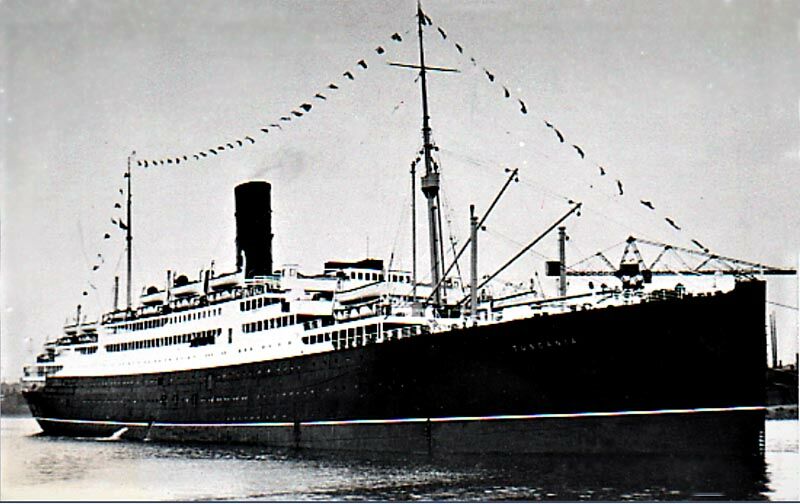
The popular “Anchor Lines” cruises
would offer voyages to the North Cape and the Mediterranean, and from the
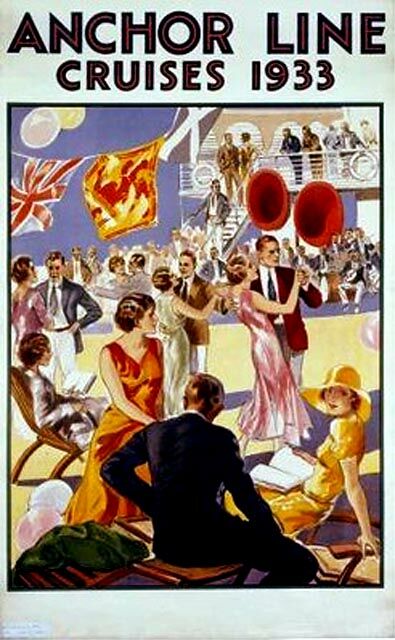
A 1933 cruise poster for the T.S.S. Tuscania looking very festive
Then late in September 1938, she made her last voyage for she had been placed on the market, although she still operated several short cruises until there was a hint of a buyer in the air.
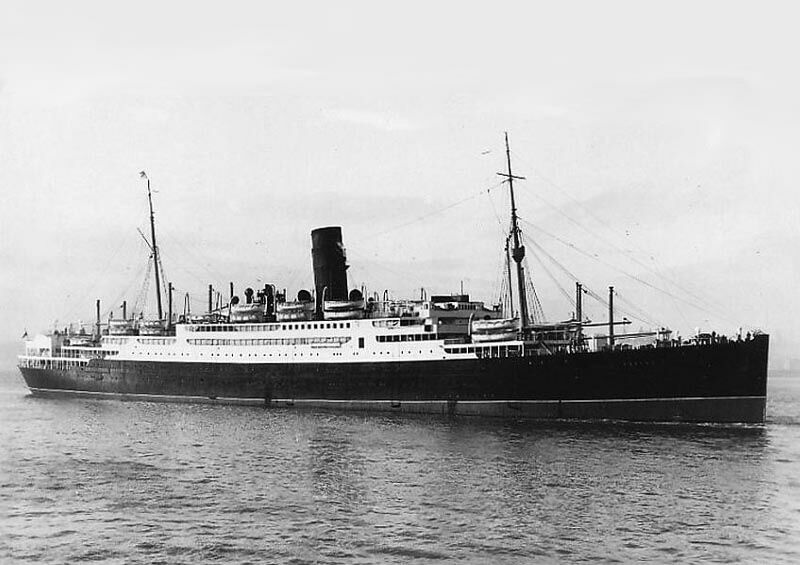
She is seen here in 1938 looking simply superb
*********************
“Tuscania” sold to the Goulandris Brothers:
Early in 1939, the 17 year old “Tuscania” was purchased by the famous shipping magnates, the “Goulandris Brothers” owners of the “General Steam Navigation Company” also known as the “Greek Line.”
She soon headed for
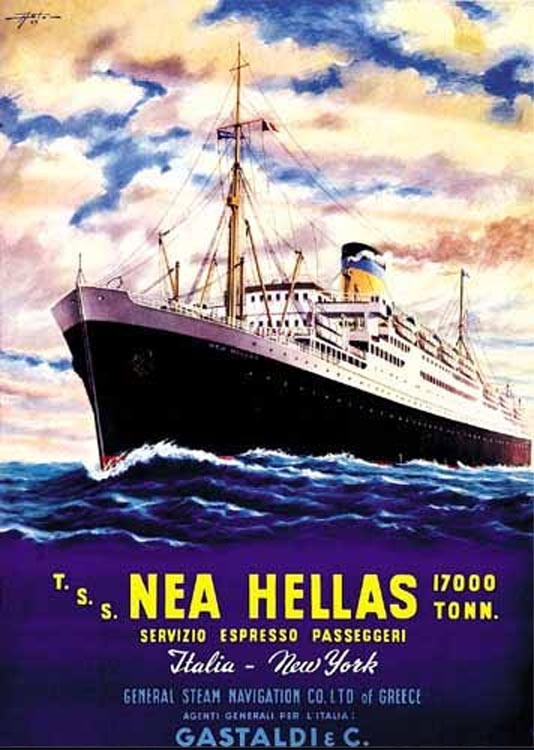
An early poster promoting the new liner “Nea Hellas”
T.S.S. Nea Hellas departed Piraeus for her Maiden Voyage on May 19, 1939, and considering that she was the first ship to sail officially for the renamed “Greek Line”, the ‘New York Herald Tribune’ reported when she arrived in New York and due to all the publicity there were countless parties held for New York’s diplomats, the social elites and many of the well known Greek businessmen, etc.
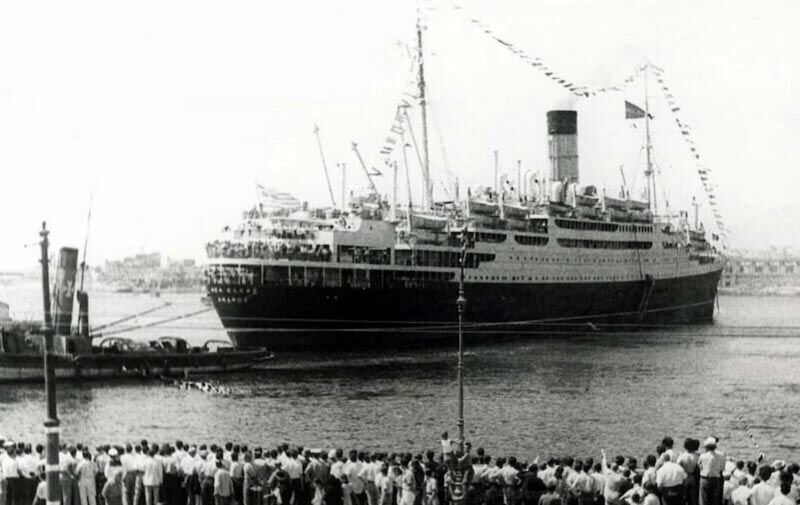
T.S.S. Nea Hellas
The “Nea
Hellas” operated nine return voyages between
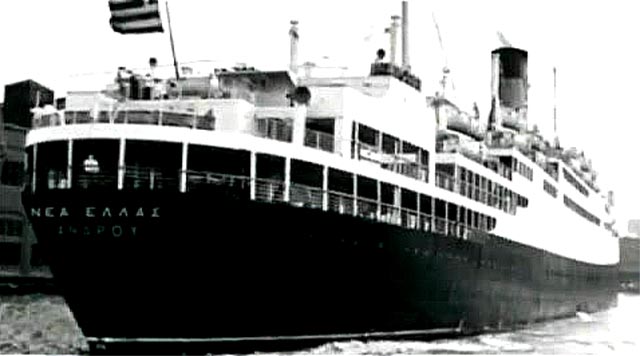
Another stern photograph of the “Nea Hellas”
World War Two services:
However, with the War having broken out in
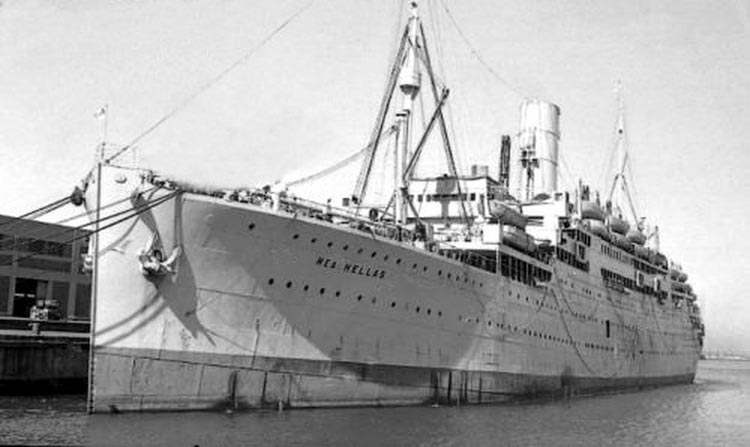
The H.M.T. Nea Hellas (HR-190) is seen as a full fledged Troop Ship
For the next six years, H.M.T. Nea Hellas sailed the world carrying troops as well as other passengers who needed to get back home, and she became known as the “Nelly Wallace,” by the Brit’s she carried into war.
Throughout the War she carried over 600,000 troops and she avoided any serious damage or loss of life despite at all times being in a principal role and in the theatre of war at sea, although she was attacked several times, but I will cover that later.
Throughout the war, the H.M.T. Nea Hellas was part of a number “WS (Winston’s Special) Convoys” that would see her sail with may other passenger ships converted into troopers, and being escorted by a host of naval ships of a vast variety, be it frigates to destroyers, etc.
Convoy WS 10, WS 10B & CM 17:
Sailing from Avonmouth on July 30, 1941,
Liverpool July 31, the
Their Escorts from the UK would be from
varying dates, and they were: The cruiser Cairo and destroyers
Whitehall, Winchelsea and Witch Aug 2 to Aug 5; armed
merchant cruiser Worcestershire and destroyers Broadway, Gurkha,
Isaac Sweers, Lance, Legion and Piorun
Aug 2 to Aug 6; cruiser London as ocean escort was relieved on Aug
10, by the cruiser Edinburgh for the remainder of the voyage.
However, the destroyer Jupiter remained with the convoy to
Local
The convoy sailed from
The following ships entered Capetown, the Britannic, Indrapoera, Nigerstroom,
Phemius, Reina Del Pacifico,
The remaining ships proceeding to
Thus in
H.M.T. Nea Hellas Attacked:
Whilst on another Convoy, the “Nea Hellas” was on her way to and close to Freetown, when suddenly on October 10, 1942, she was attacked, twice by the Italian submarine ‘Archimede’ in a position S.W. of Freetown, in the Central Atlantic. Although the torpedoes hit her hull, but thankfully they did not explode and the she was able to escape at maximum speed. This was the very same sub that sank another large troopship one day earlier the Orient Line’s 20,001 GRT, S.S. Oronsay. Elsewhere on October 9 & 10, troopships “Duchess of Atholl” 20,119 GRT - Canadian Pacific’s S.S. Coy, and the Orient Line’s 23,456 GRT, S.S. Orcades were torpedoed and sunk. However, in addition to the Italian submarines torpedo’s near-miss, the “Nea Hellas” was the subject of three further separate attacks from the air by German aircraft, and believe it or not, all were completely unsuccessful. Therefore the “Nea Hellas” fared very well indeed, for she was the lucky ship!
Combined convoy WS 28 / KMS 11:
The H.M.T. Nea Hellas was part of one of the “WS (Winston’s Special) Convoys” and she sailed from the Oversay Island (UK) rendezvous on March 16, 1943. The convoy was divided into convoys WS 28 and KMS 11 at sea five days later. There were a total with 38 other Troop ships in this group, which included the “Nea Hellas”.
Also sailing along were naval auxiliaries H.M.S. Bulolo, H.M.S. Largs and the H.M.S. Ulster Monarch were part of the convoy.
On assembly off Oversay the following naval escorts were with the convoy; sloops H.M.S. Wren, H.M.S. Woodpecker, destroyer H.M.S. Douglas and the escort destroyers H.M.S. Badsworth, H.M.S Eggesford, H.M.S. Whaddon, HMS Goathland and ORP Krakowiak.
Then on March 21, the convoy split up into two
sections, KMF 11, made up of “Banfora”, “Cuba”, “Johan
van
Oldenbarnevelt”, “Ormonde”, “Orion”, “Nea
Hellas”, “Rangitata”, “Windsor
Castle” and the H.M.S. Ulster Monarch which proceeded to
Algiers arriving on March 23, 1943, being escorted by the original escort, but
without the H.M.S. Douglas that was forced to put into Gibraltar on
March 22 due to damage to her port propeller. However, after an inspection it
turned out that she was able to continue, but she could not sail more than 22
knots and it was decided that she could rejoin the convoy. All five escort
destroyers also put into Gibraltar to fuel but departed later that day to
rejoin the convoy at
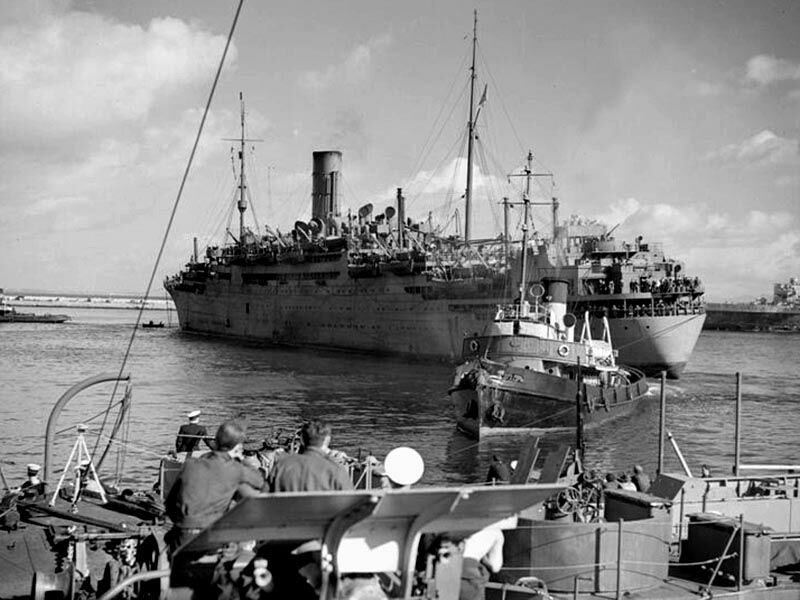
Trooper “Nea Hellas” is being berthed at
However at 0254 hours on the 23rd the 19,141
GRT, “Windsor Castle” was torpedoed by a German He.111
from I/KG 26 in position 37°28'N, 01°10'E. Her crew and troops were taken off
by the H.M.S. Wren, H.M.S. Eggesford and the
H.M.S. Whaddon. It was reported that the last two
ships were dangerously overloaded with survivors as the “
The “Nea
Hellas” Returned to the
Combined convoy WS 29 / KMS 13:
Once again, this combined convoy was formed off Oversay on April 16. 1943. The convoy KMS 13 was divided with another convoy at sea on April 20, 1943 being for the second part of the fleet - WS 29.
Thus the “Nea
Hellas” departed under convoy WS 29, and then four days later was
transferred to convoy KMS 13, as she departed independently on April 20, being
bound for
In July the “Nea
Hellas” operated a voyage with an escort filled with Canadian troops who
would disembark at Philippeville in

Her we see the ships heaviest armaments

Jason advised me that this was “Private H.R. Stevens” who was on gun duty; it was obviously a Bofors gun
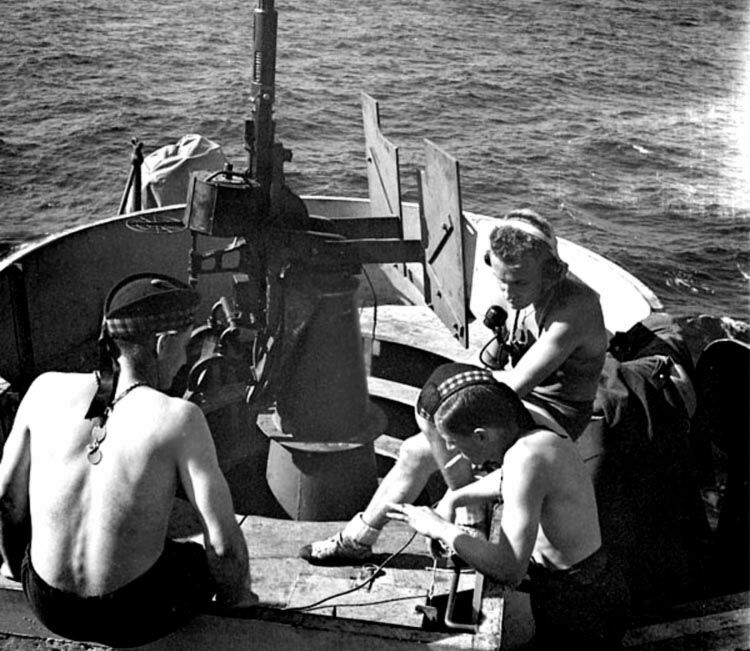
Canadian Infantry reinforcements of the 48th Highlanders are seen beside a 20 mm Oerlikon anti-aircraft gun
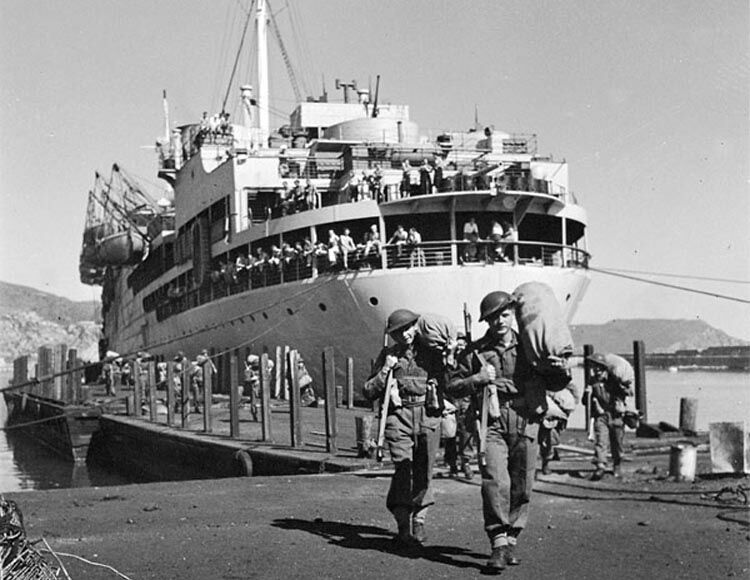
Here we see the
Canadian Troops leaving the “Nea Hellas”
at
Combined Convoy WS 32 & KMF 20:
Escort was provided by destroyers Beagle,
Bulldog and Douglas Aug 8 to Aug 12, frigates Derg,
Kale and
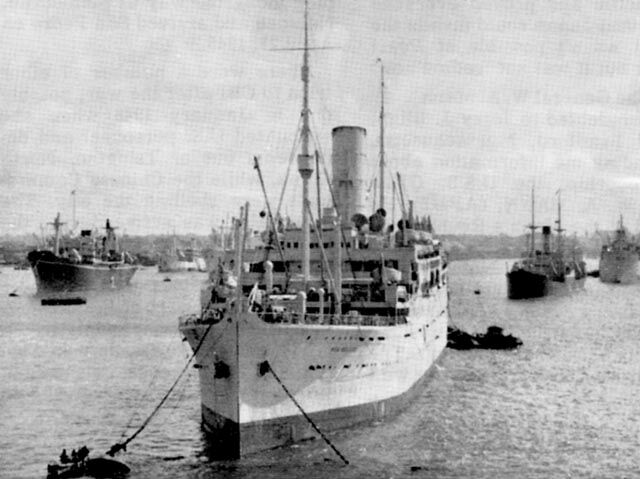
H.M.T. Nea Hellas (HR-190) is seen here at
The above are just some of the examples of her hectic trooping duties, for she was certainly very busy for the entire six years of the War!
*********************
In 1947, she was returned to the “Greek Line” and she was thoroughly refitted and modernised, and she would now accommodate 300 passengers in First Class, 310 in Tourist Class, and 850 Third Class.
Upon her completion the T.S.S. Nea Hellas would now serve as
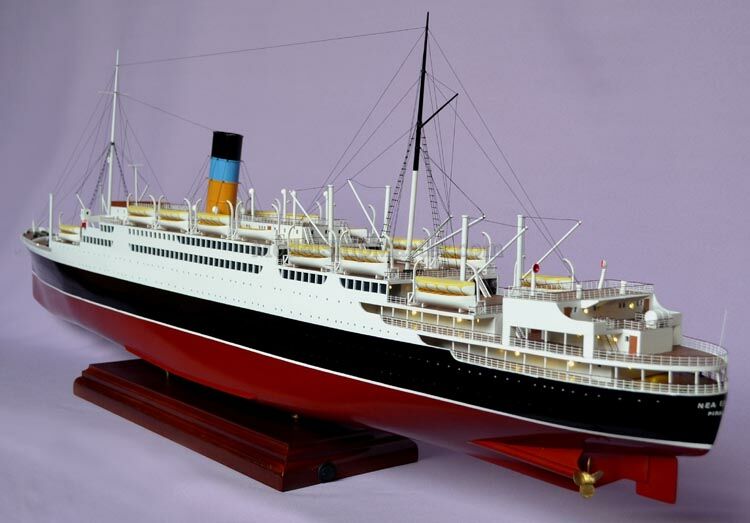
A Beautiful model of the Greek Line’s T.S.S. Nea Hellas
Model available from;
www.modelshipmaster.com/products/ocean_liners/Nea-hellas-passenger-ship.htm
During her life, she carried over 800,000
Greek and other European immigrants to
The “Nea
Hellas” was chartered by the “International Refugee
Organisation” - the “IRO” for a voyage on January 24, 1949
sailing from
She headed home and soon she returned to her regular Trans-Atlantic services and winter cruises until 1955, but it was then she was replaced by the new 22,979 GRT brand new S.S. Olympia.
*********************
Her New Name - “New
York
Thus in 1955 the “Greek
Line” decided to rename her “
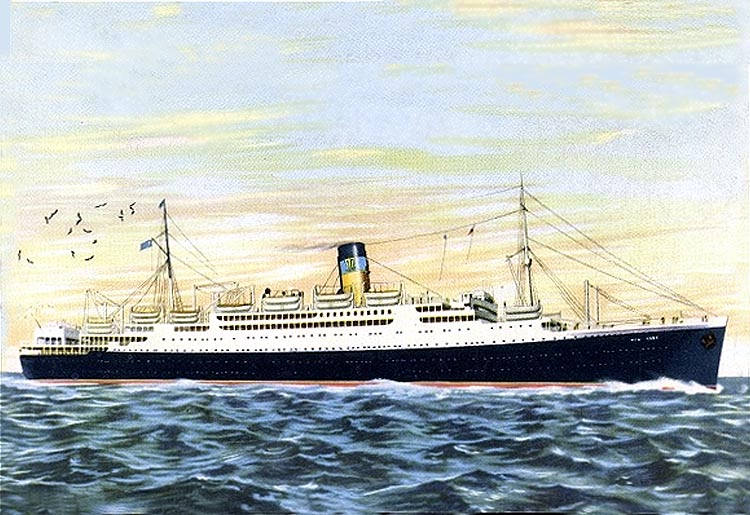
A ‘Greek
Line’ postcard of the updated and renamed T.S.S.
The T.S.S.
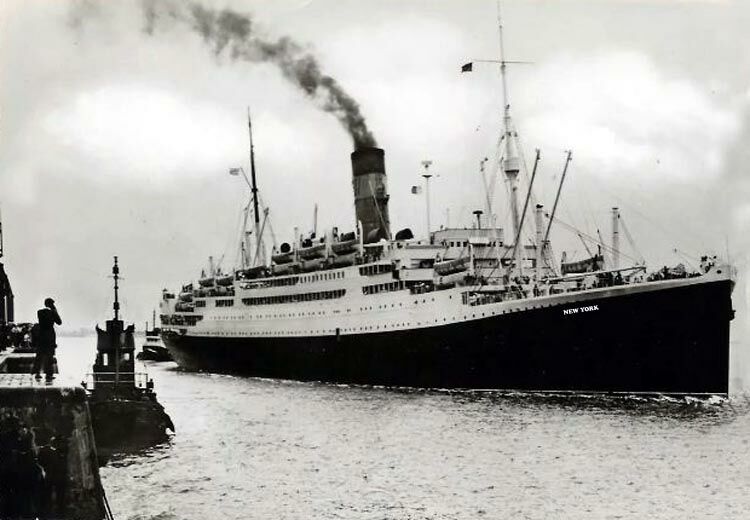
The “
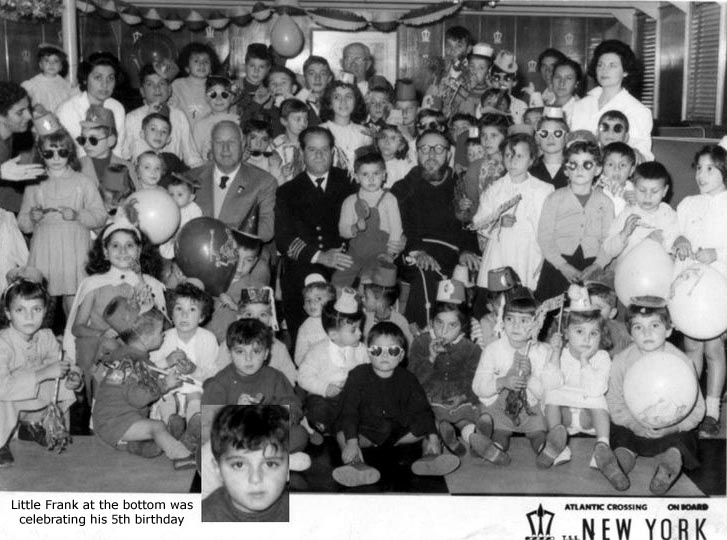
Little
Frank’s 5th Birthday party on board the T.S.S.
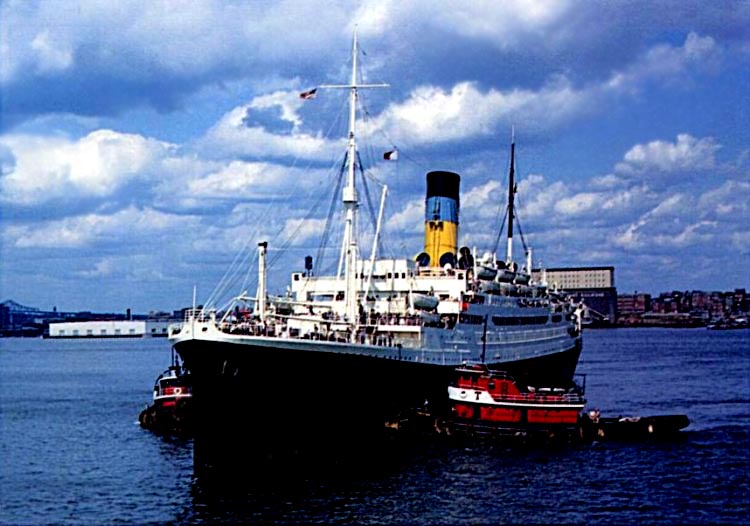
The T.S.S.
Her concluding Days:
October 13, 1959, the “
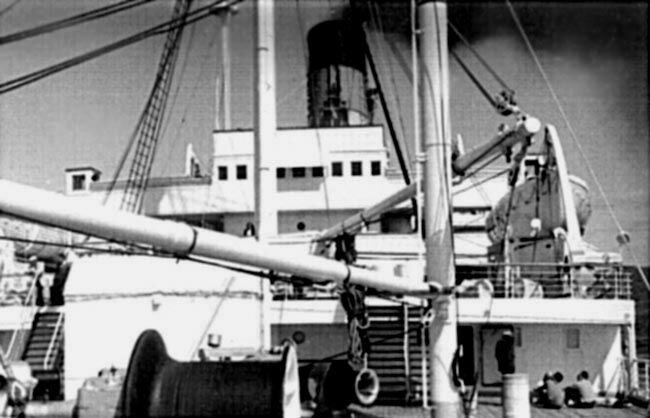
Looking from the Foc’sle towards the Bridge
*********************
Her Final Days:
Having been in the water for a good 40 years, but for twenty of those years, half of her life at sea, she had been a Greek liner. The Greek Line with the arrival of their new ship and a fine fleet, had no use for her any more, thus they decided to sell her, which they did to a Japanese breaker for £312,000.
On August 19, 1961, she departed
In Conclusion:
The grand old lady was gone, but the memory of the once glamorous T.S.S Tuscania, then the more modest “Nea Hellas” and “New York” may well have remained on in the minds of those that were fortunate to roam her decks, eat in her restaurants, and enjoyed the good life on the seas, whilst they were on board. Although she not have had the status of some of the other more prominent grand luxury liners that sailed the Atlantic, she was certainly a fine workhorse that allowed thousands upon thousands of individuals and their families to travel to the New World in style and comfort and discover a new life.
*********************
T.S.S. Tuscania, Nea Hellas &
Names: Tuscania: 1922-1939.
. Nea
Hellas: 1939-1955.
.
Owners: Anchor Line: 1922-1939.
. General
Steam Navigation Company of
. British
Government: 1941-1947.
. General
Steam Navigation Company of
Operated by: Anchor Line 1922-26, 1931-1939.
. Cunard Line: 1926-1931 (summer only).
. Anchor Line: 1941-1947.
. Greek Line: 1939-1941 & 1947-1961.
Registered
at: Glasgow,
Scotland, 1922-1939 & 1941-1947.
.
Builder:
Yard N°: 595.
Launched: October 4, 1921.
Sea Trails: September 8 1922.
Maiden Voyage: September 16, 1922.
Official No: 146307.
Category: Passenger vessel.
Route:
. Troopship 1941-1947.
.
.
Tonnage: 16,991 GRT, 10,016 NRT.
1937: 17,001 GRT.
Length: 552.3 ft – 168.3 m.
1937: 175.05 m - 574.31 ft after refit & lengthening.
Beam: 70.3 ft – 21.4 m.
Depth: 38.6 ft - 11.76 m.
Installed
Power: Six Brown
Curtis steam turbines, producing 12,500 BHP, DR geared to two shafts. By
Speed: 16 knots service speed, 17.5 knots maximum.
Accommodations:
1922: 240 First,
377 Second, 1,818 Third, Crew: 346.
1929: 206 Cabin,
439 Tourist, 485 Third Class.
1939: 200 Cabin Class, 400 Tourist Class, 500 Third Class.
1947: 300 in First
Class, 310 in Tourist Class, and 850 Third Class.
1955: 80 First Class passengers and 1,369 in Tourist Class.
Crew:
1922: 346.
1926: 280.
1939: 200.
1955: 320.
Fate: Sold & broken up at Onomichi in Japan October/November1961.
*********************
Remembering the Delightful
T.S.S. Tuscania (2)
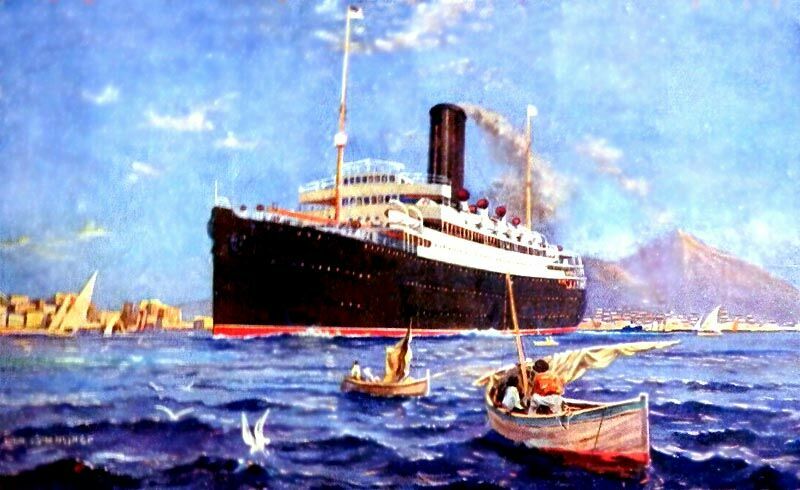
An excellent
artist impression of the T.S.S. Tuscania is seen in the
“Blue
Water Liners sailing to the distant shores.
I watched them come, I watched
them go and I watched them die.”
Featuring over 1,435 Classic Passenger Liners, Passenger-Cargo Liners & Classic Cruise Ships!
Or ENTER HERE
For interest: Sadly an email service to ssMaritime is no longer available, due to the author’s old age and chronic illness as well as being disabled, etc. In the past ssMaritime received well over 120 emails per day, but Mr. Goossens can no longer handle same. He sincerely regrets this!
*********************
ssMaritime.com & ssMaritime.net
Where the ships of the past make history & the 1914 built M.S. Doulos Story.
The Author has been in Passenger Shipping & the Cruise Industry for well over 60 years
In addition he was the founder of “Save the Classic Liners Campaign” in 1990.
Please Note: ssmaritime and associated sites are 100% non-commercial and the author seeks no funding or favours of any shape or form, never have and never will!
Photographs on ssmaritime and associate pages are by; the author or from the author’s private collection. In addition there are some images that have been provided by Shipping Companies and private photographers or collectors. Credit is given to all contributors. However, there are some photographs provided to me without details regarding the photographer/owner concerned.
This notice covers all pages; although, and I have done my best to ensure that all photographs are duly credited and that this notice is displaced on each page, that is, when a page is updated!
ssMaritime is owned & © Copyright by Reuben Goossens - All Rights Reserved

